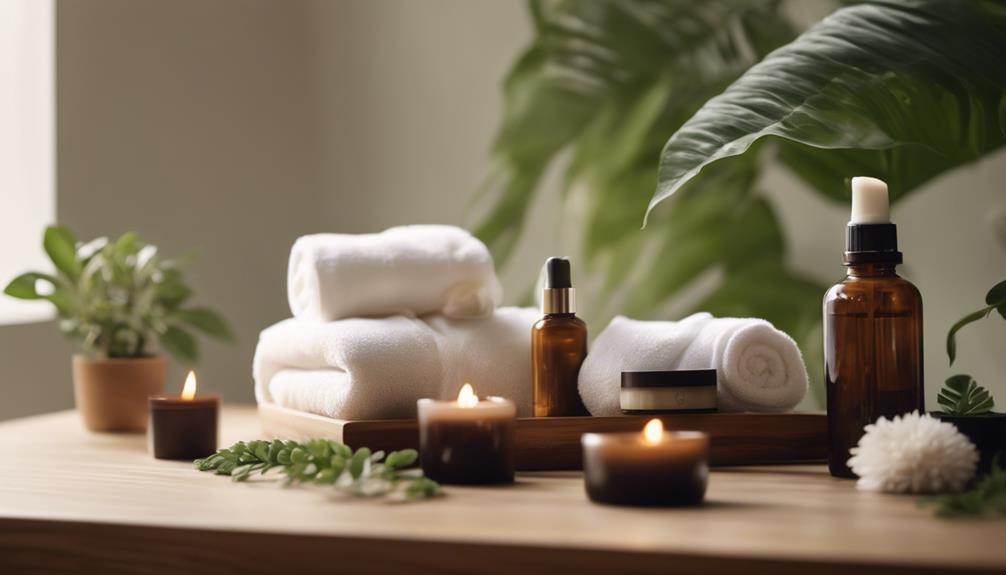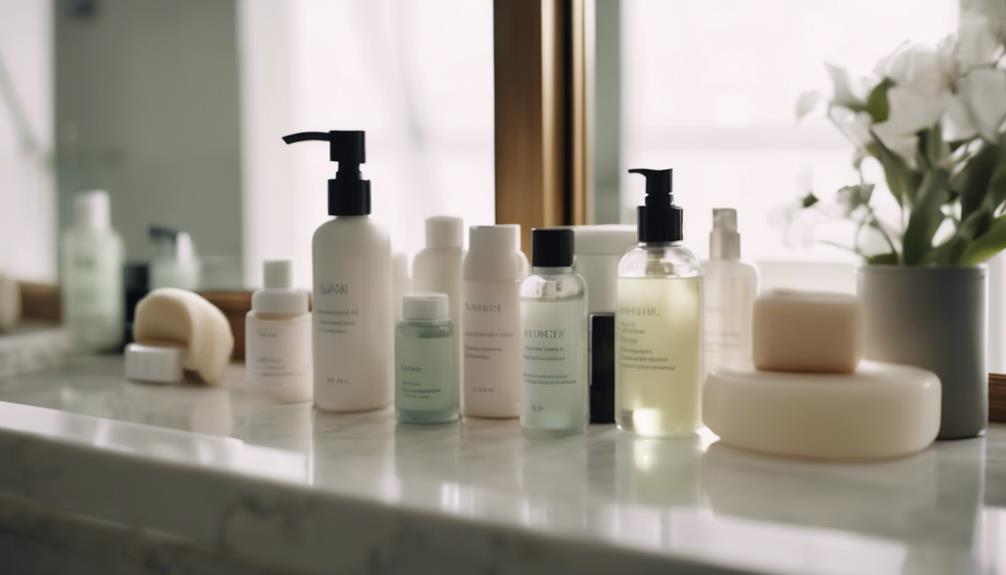Dermatologists swear by five skincare secrets that can elevate your routine. First, know your skin type to select the right products. Next, make daily sun protection a priority with a broad-spectrum SPF 30 or higher. Simplify your regimen to include just a gentle cleanser, sunscreen, and a suitable moisturizer. Don't forget to monitor your skin regularly for any changes, as early detection is key. Finally, choose effective products like antioxidant-rich serums tailored to your needs. Want to uncover more expert tips and tricks? Keep exploring to enhance your skincare knowledge!
Key Takeaways
- Always identify your skin type to choose the most effective products for your unique needs.
- Apply broad-spectrum sunscreen daily, reapplying every two hours for optimal protection against UV damage.
- Maintain a simple skincare routine focusing on a gentle cleanser, sunscreen, and a suitable moisturizer.
- Regularly monitor your skin for changes and consult a dermatologist for any concerning irregularities.
Understand Your Skin Type
Understanding your skin type is essential for choosing the right products that won't cause irritation or breakouts. Identifying whether you have sensitive skin, dry skin, oily skin, or combination skin helps you select tailored products that work for your unique needs.
If you have sensitive skin, you might experience stinging or burning sensations with certain ingredients, so opt for gentle, hypoallergenic skin care products.
For dry skin, look for richer moisturizers containing humectants and emollients to combat flakiness and roughness.
Oily skin, on the other hand, often appears shiny and can benefit from lightweight, non-comedogenic products that keep pores clear and prevent breakouts.
Combination skin presents its challenges, as it requires a balance between these two extremes. You'll need to use tailored products that address the dry areas without exacerbating oiliness in others.
Prioritize Daily Sun Protection

Daily sun protection is a non-negotiable step in your skincare routine to shield your skin from harmful UV rays. Using broad-spectrum sunscreen with an SPF of 30 or higher is crucial for effective UV protection.
Here are three key practices to prioritize:
- Apply Sunscreen Daily: Make sunscreen a part of your daily routine, even on cloudy days. It considerably reduces the risk of skin cancer, with studies showing daily application can lower melanoma incidence by up to 50%.
- Reapply Regularly: Don't forget to reapply every two hours, or immediately after swimming or sweating. This guarantees your skin remains protected throughout the day.
- Consider Tinted Sunscreen: Tinted sunscreens not only provide sun protection but also help conceal blemishes, giving you a smoother complexion while you protect the skin.
Additionally, wearing sun-protective clothing with a UPF label can offer extra defense against UV radiation.
Simplify Your Skincare Routine

Keeping your skincare routine simple can make a significant difference in maintaining healthy skin without overwhelming it with too many products. Focus on a minimalistic approach that includes a gentle cleanser, a broad-spectrum sunscreen with SPF 30 or higher, and a moisturizer tailored to your skin type. This streamlined skincare routine helps you avoid irritation and promotes effective results.
Establish consistent morning and nighttime routines to guarantee your skin receives the necessary care throughout the day. By sticking to these routines, you promote skin health and allow your skin to thrive. Consider using dual-action products, which combine multiple benefits, saving you time and enhancing efficiency in your regimen.
Additionally, it's vital to regularly evaluate and adjust your skincare routine based on your skin's changing needs. Factors like seasons, stress, or hormonal changes can all impact your skin, so pay attention and adapt accordingly.
Monitor Skin Health Regularly

Regularly monitoring your skin health is essential for catching potential issues early, especially since skin cancer affects one in five Americans during their lifetime. By taking proactive steps, you can improve your chances for early detection and better outcomes.
Here are three key practices to incorporate into your routine:
- Self-examinations: Regularly check your skin for new or changing spots. Pay attention to any irregularities, as these could be signs of potential skin issues.
- Full-body skin exams: Dermatologists recommend starting full-body skin exams at age 30. These thorough check-ups help assess and track changes in skin health over time.
- Seek professional advice: If you notice any changes in your skin that concern you, don't hesitate to consult a dermatologist. They can provide expert guidance and evaluate any potential risks.
Choose Effective Products Wisely

Monitoring your skin health is only part of the equation; choosing effective products wisely plays a significant role in maintaining and enhancing your skin's appearance and health.
Start by identifying your skin type and selecting products that cater specifically to its needs. For example, if you have oily or acne-prone skin, opt for gentle exfoliating cleansers containing AHA or BHA to improve clarity without irritating the skin.
When it comes to sun protection, always choose broad-spectrum sunscreens with an SPF of 30 or higher. This guarantees you're shielded from harmful UVA and UVB rays, reducing the risk of skin cancer and premature aging.
Incorporating serums rich in antioxidants, like vitamin C, can also brighten your complexion while defending against free radicals that accelerate aging.
Be vigilant about product formulations; avoid harmful additives such as fragrances and alcohol, which can irritate the skin, especially if you have sensitive skin types.
Frequently Asked Questions
What Is the #1 Dermatologist Recommended Skincare Brand?
If you're looking for the top dermatologist-recommended skincare brand, SkinCeuticals is it. Known for its effective formulations, especially C E Ferulic, it focuses on prevention, protection, and correction for healthier, more youthful skin.
What Skin Cream Do Dermatologists Recommend?
Dermatologists often recommend SkinCeuticals C E Ferulic for its powerful antioxidant properties and Obagi Hydrate Facial Moisturizer for hydration. Both products cater to various skin types, ensuring you receive effective care without clogging your pores.
What Not to Say to a Dermatologist?
When talking to a dermatologist, don't say all products are the same, dismiss sunscreen's importance, insist on quick fixes, claim you've tried everything, or downplay how diet and sleep impact your skin health.
What Is the Best Skincare Routine for a 60 Year Old?
What if you could turn back time? Start your skincare routine with a gentle cleanser, nourishing moisturizer, and broad-spectrum sunscreen. Then, add retinoids, antioxidants, and gentle exfoliation to reveal your skin's radiant potential.
What are the Skincare Secrets That Dermatologists Disagree with the Myths?
Dermatologists have their fair share of skincare myths to debunk. One secret they disagree with is the idea that more products mean better skincare. In reality, using too many products can irritate the skin. They also advise against over-exfoliating, as it can damage the skin’s barrier.
Conclusion
In the grand tapestry of skincare, you hold the brush.
By understanding your unique skin type, embracing daily sun protection, and keeping your routine simple, you're already on the path to radiant skin.
Regularly checking in on your skin's health and choosing effective products will weave the finishing touches into your masterpiece.
Remember, every glow tells a story, and with these dermatologist-approved secrets, you're crafting a tale of beauty that's all your own.








